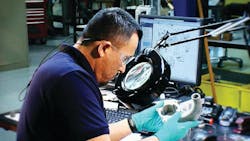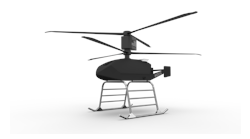MRO Operations: Aftermarket Solutions
Major maintenance on helicopter drive train components having specific overhaul times, life-limited parts, and other unique requirements is generally reserved for the maintenance repair overhaul (MRO) organization having dedicated facilities, specialized equipment and tooling, inspection and repair processes, and technicians having specialized skills and training. These facilities will have machining equipment, cleaning and nondestructive testing lines, welding sections, test or flow benches, paint booths, and are more similar to a specialized machine shop than the typical aircraft maintenance facility. Many times these specialized facilities provide MRO services for both civilian and military customers.
I recently had the opportunity to visit such an MRO facility; Timken Aerospace Aftermarket Solutions in Mesa, AZ, where a steady volume of repair and overhaul takes place on Pratt & Whitney Canada PT6A and PT6T TwinPac engines, Honeywell T-53 engines, Bell Helicopter drivetrain components, and Rolls-Royce 250 component repair. Some of the more complex units repaired and overhauled there are the Bell 212 and 412 transmissions, Bell 412 main rotor heads, and the Honeywell T-53 fuel control units.
More than just bearings
I, like many other people, naturally associate the name Timken with bearings – and rightfully so as it has been manufacturing bearings of all sizes, shapes, and applications for decades. But that’s certainly not all it does. Erik Paulhardt, vice president of Timken’s Aerospace and Defense segment, explains, “The Aerospace and Defense group is an original equipment manufacturer (OEM) for rotorcraft transmission assemblies, and a variety of complex parts for gearbox and engine applications including bearings. We also produce a host of engine, gearbox, and other piece parts, including bearings, under Parts Manufacturing Approval (PMA). The rest of the Bearings and Power Transmissions Group focuses on the manufacture and repair of roller bearings, ball bearings, gear and chain products for use in numerous OEM and aftermarket industrial market segments.”
Larry Shiembob, director of aerospace aftermarket, says, “We really have the helicopter industry covered as a supplier providing new OEM bearings to helicopter manufacturers as well as replacement parts and numerous MRO services. Our MRO services include working on transmissions, gearboxes, main rotor components, gears, housings, certain turbine engines, and of course bearings. These capabilities place us in the unique position of being able to provide MRO for drivetrain components, repair for piece parts and bearings, provide OEM and/or PMA replacement parts, and provide engine overhaul for certain turbine engine models for light to medium size helicopters.” All bearing repair work is accomplished at the Timken facility in Los Alamitos, CA. Shiembob concludes, “We work with the customer to make sure they understand what options are available and to help them determine which option to choose.”
The Mesa facility employs approximately 80 people and about 90 percent of the shop technicians are FAA certificated either with an Airframe and Powerplant or a Repairman certificate. In the shop are experienced A&Ps, new A&Ps, and former military technicians having helicopter maintenance experience. Technicians receive a blend of ongoing training depending on what their role is including factory training, in-house classroom, and on the job training. Staff may be cross-trained as Timken views this as an advantage, making technicians flexible and allowing better support for the customer base.
Transmission overhaul
In the shop, I spoke with Brandon Clausen, mechanic – component repair, on the transmission overhaul line. He was nearing completion of a main transmission overhaul from a Bell 204 series helicopter. We spoke about common problems found during overhaul on this type of unit. He replied, “Internal corrosion is one of the common problems that we experience in the overhaul process. The time that the aircraft sits idle can be more detrimental to certain piece parts of the assemblies. The overhaul time for this unit is 1,100 hours, but depending on the type of operation it could take up to eight years or more, and often times will include periods of extended downtime. Depending on the environment and storage conditions, moisture will collect and sit in low lying areas and create problems.”
Clausen showed me a transmission oil pump gear rotor assembly or G-rotor and explained, “This badly corroded rotor for the oil pump of the transmission assembly is a common shop rejection. Most rotors are rejected for excessive wear of the polished surfaces. This one was so badly corroded it would not come apart; a common issue for units that sit idle for prolonged periods of time.” He went on to say, “When an operator sends in a unit, we provide a quote for the overhaul, and due to unknown problems like this one, the overhaul cost can be more than they expected. Often times the customer may question the inspection and findings because of a low time since overhaul (TSO) on their component.” Again he repeats that the time the aircraft sits idle can be more damaging than high use in some cases.
Engine test cell
John Hoban, facilities site leader, proudly showed the recently completed turbine engine test cell. Designed and built by Test Logic located in Middletown, CT, the cell has two bays with separate control panels allowing two engines to be run simultaneously. The test cell appeared similar to other state-of-the-art test cells of its size, with one interesting exception. The air inlet system has coolers inside that introduce moisture, reducing the temperatures at the engine by as much as 20 F. I was quickly reminded we were in the Arizona desert where summertime temperatures can easily reach well above the acceptable range for engine and test cell operation. Hoban explains, “Each air inlet system was designed to contain a device that we here in the Southwest call a “swamp-cooler.” Without this feature, there would be times when operating the test cell would be restricted due to the high temperature, potentially adding delays to the overhaul turn-times.”
Specialized services and aircraft maintenance
I had an interesting discussion with Larry Shiembob regarding a facility providing specialized MRO services that is separated in location from aircraft, an airport, and doesn’t have the typical flying machines inside the typical hangar to look at, work on, or touch and see every day. We discussed how to maintain the sense of “aircraft maintenance” among the staff when on the surface a company providing specialized services is more similar in some ways to other industrial machine shop environments, rather than a traditional aircraft maintenance facility.
Shiembob quickly responds, “That’s not an issue here. We’re fortunate that our technicians have a lot of interface with our customers and helicopter operators. They are routinely asked to assist in the field with a variety of tasks from troubleshooting to rigging an engine. We maintain a very high sense of aircraft maintenance and aviation in our shop. Ask the guys in the shop and see for yourself,” he concludes.
In the shop I passed by a number of work benches, storage cabinets, and desks displaying the FAA Personal Minimums Checklist. I was introduced to Steve Davis, chief inspector, who explains, “I have been an FAA Safety Team (FAASTeam) representative for five years. This provides me the ability to keep the sense of aircraft maintenance and aviation safety in front of everyone here.” He goes on to explain how he communicates FAASTeam information by posting written communications throughout the shop and presenting related FAASTeam information to all technicians during monthly quality meetings. Shiembob was right.
When asked what advice could be provided to maintainers in the field regarding drivetrain components Shiembob says, “By following the preventative maintenance and inspection guidelines, time in service increases and repair costs decrease. One of the common things we see is when customers take equipment off-line for an extended period of time. They should look into the storage and preservation process. Taking these extra steps extends the life of the engine and components.”
So yes, bearings are what the name Timken is historically associated with, but their capabilities are much greater, including specialized MRO services for light to medium helicopters. For more information visit: www.timken.com/en-us/solutions/aerospace/aftermarket.


